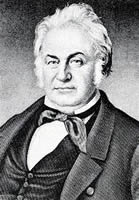North Carolina War Between the States Sesquicentennial
Regiments to Defend The Old North State
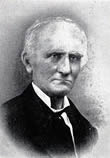
“The President must have known that all of us in the Slave States, who in spite of the unfriendly action of the North,
had barely become able to stand up for the Union would be crushed by the first gun he fired against the South.
I believed he still desired to protect our rights and preserve the Union, and that he had some sympathy with
those of us who had breasted the current of Disunion, and that he would not voluntarily drive us out of the Union –
I hoped and believed, that when he and his [sectional] party had attained control of the government, that he was
enough of a statesman and a patriot to exert his powers to protect our rights and preserve the Union.”
North Carolina Unionist Jonathan Worth
(North Carolina Historical Commission, J.G. de Roulhac Hamilton, editor, Volume I, Correspondence of Jonathan Worth,
letter to the people of Randolph County, May 1861, Edwards & Broughton, 1909)
Preparations to Repel the Coming Invasion
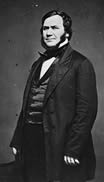
John Adams Gilmer
“We are all one now,” said John A. Gilmer, a staunch Unionist, to George Howard, equally staunch
Secessionist, when they heard the news of the firing on [Fort] Sumter and Lincoln’s call troops.
After the adoption of the Ordinance of Secession, all factions in North Carolina agreed to bury their
differences and unite in defence of the State. Everywhere there was sincere rejoicing in this new-found unity
of parties that had been fighting each other for a generation.
If in some hearts there lingered regrets for the old union, such regrets were sternly repressed by the
psychology of the situation. The coalescing of the political and social forces in the State was accelerated
by the practical problems that confronted North Carolina as a member of the Confederacy. For it was
clear by May, 1861, that peaceable secession was an impossibility.
The United States government already had plans under way for a blockade of all Southern ports and for
an invasion of Southern territory not only be Federal forces, but also by volunteers from the States remaining
in the old Union. The struggle was literally a war between the States. North Carolina had her place by the side
of her Southern sisters and was prepared to throw her whole strength to their defence.
She went out of the old Union reluctantly; she went into the new Confederacy with enthusiasm."
John Adams Gilmer, North Carolina Unionist
Militias Prepare for a Coming Conflict:
Diary of Catherine Edmundston, October 29, 1860:
“Their beautiful new [Scotland Neck Mounted] Rifle uniforms. Blue faced with green getting soaked [in the rain],
& their saber scabbards actually tarnishing as you looked at them. Then when it came the Captain’s turn to speak,
how well he did it! As he took the flag from Mr. [Richard H.] Smith’s hand…[and] grasping the Flag staff with one
hand whilst the other he managed his horse, he made a handsome and appropriate speech to the ladies,
thanking them for the beautiful gift [of the flag] & pledging himself & his men to defend it with their lives.
Then turning towards his men his voice rang like a clarion as he…exhorted them to “rally under its folds,”
& delivering it to the Cornet, ordered a salute! The band played “Star Spangled Banner.” The parade was
dismissed & all was over. The Flag is a beautiful one of Blue Silk with heavy bullion fringe & tassels. On one
side is the Coat of Arms of [North Carolina] surrounded with gold stars, one for each State; on the other a wreath
of Corn in the Silk & ripe Ear, Cotton in blossom & bole, & wheat encircling the words Scotland Neck Mounted Riflemen –
Organized Nov 30th 1859, & on the ribbon which ties the wreath the words “Pro aris et focis.”
(Diary of a Secesh Lady, pp. 11-12)
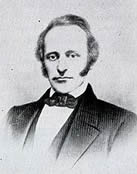
Governor Ellis Puts the State on War Footing:
“[Governor John W.] Ellis’s accomplishments on behalf of North Carolina are best seen in two letters
written to President Jefferson Davis. On 25 April he reported the seizure of Forts Macon, Johnston,
and Caswell together with his opinion as to their relative strength and importance. He also reported the
seizure of the United States Arsenal at Fayetteville with thirty-seven thousand stand of arms and
arms-making equipment. He concluded this letter, “The people of my State are now thoroughly
united and will adopt the speediest method of union with the Confederate States.”
Two days later he wrote:
“The State is to all intents practically out of the Old Union, and we are discussing the speediest mode
of giving legal sanction to this State of facts. Unexampled unanimity prevails and we will be a member
of the Confederate States by the 20th May…..All the lights have been extinguished on the Coast.
Vessels have been sunk in Ocrac[oke] Inlet and a fleet of armed vessels (small) is now being fitted out
to protect our grain crops lying on the inland waters of the No. East part of the State. A good Ship Canal
connects those waters with the Chesapeake at Norfolk.
Beaufort Harbor, protected by Fort Macon is a most eligible point for privateering & Dept[h] of water on
the bar is from 17 to 21 ft. We have on these waters some bold and Skilful Seamen who are ready to go
out as privateers at once. The forms required in procuring letters of Marque present a great obstacle.
Had you and authorized agent here who could deliver letters and receive the bonds &c. the work would
be greatly facilitated. The enemy’s commerce between N[ew] York and all the West Indies and South
American ports could be cut off by privateers on the coast of No. Ca.”
On 29 April, he issued an order through John F. Hoke, adjutant general, to Colonel Elwood Morris, engineer,
“to proceed to Okracoke and Hatteras, plan and construct fortifications….” And on 30 April, General William
H.C. Whiting, from his coast defense headquarters at Wilmington, reported that “the secretary of war of
the Confederate States has directed the transfer to North Carolina of 20 thirteen pds cannonade guns
from the Virginia navy yard for flank defences of Forts Macon & Caswell & for defence of the line
of the [Neuse] against [land expeditions].”
On 1 May, the governor addressed the opening session of the General Assembly. Declaring that
“the right now asserted by the constituted authorities of that government, to use military force for the
purpose of coercing a State to remain in the Union against its will, finds no warrant in the Constitution,”
Ellis proceeded to demonstrate that neither the Declaration of Independence nor the Constitution
gave or intended to give such authority to the central government.”
(The Boy Colonel, The Life and Times of Henry King Burgwyn, Jr., Archie K. Davis, UNC Press, 1985, pp. 76-77)
The Greensboro Patriot of early 1861 was a leading Unionist newspaper in North Carolina and
thought to be the expression of former Gov. John M. Morehead, though not his official organ. The editor
"plainly expressed the doctrines of James Madison that, while not allowing the right of secession,
except as revolution, that the Constitution gave no power of coercion" to the federal government.
He was sure that "a million and a half strong Union men" in the north would oppose Lincoln's
invasion of the South. The editor went on to "outline reconstruction after victory" over Lincoln's
usurpations and subsequent treaty with the North. One conditino should be that "North Carolina is
a free and independent sovereign State," and will determine whether she wishes to
reconstruct the Union or join the Comnfederacy."
Repel the Enemies of North Carolina!:
“On April 17th Virginia, in secret action, seceded, and on the same day, Governor [John W.] Ellis
of North Carolina, drew his call for a special meeting of the [General] Assembly for May 1, 1861;
but Virginia did not announce her action until April 24 and Ellis’s proclamation was published in the
[Greensboro] Patriot of April 25th. He also called upon the militia and among those who responded
were the Guilford Grays and Minute Men under Captain W.S. Hill.
The arsenal at Fayetteville was captured by a thousand volunteers. “On Tuesday” (23d April] said
the Patriot, “our streets were filled with an excited crowd. They were addressed by Mr. J.W. Thomas
of Davidson, [former] Governor [John M.] Morehead, Hon. R.C. Puryear, Hon. J.A. Gilmer,
Ralph Gorrell, Esq., Samuel P. Hill, J.R. McLean, R.P. Dick,
Thomas Settle and perhaps others.
The speeches of all these gentlemen all breathed the true spirit of resistance to tyrants, and that
the time had come for North Carolina to make common cause with her brethren in the South in
driving back the Abolition horde. North Carolina may rest assured that the people of Guilford are all right.”
The Guilford Grays, under Capt. John Sloan, were at Fort Macon on duty. Two other companies
were organizing…..A company of Home guards, also, under Capt. Jos. A. Houston, was organized
and the ladies forming organizations to provide supplies and hospital appurtenances.
It is a curious fact that when the Guilford Grays started for Goldsboro on the first call, both Senator Gilmer
and Judge Dick – Whig and Democrat – and Richard Sterling, as well, said to them substantially:
“Go! Defend your State! Carry with you the Stars and Stripes, and fight under that banner! Repel any
armed force that puts foot on North Carolina soil – whether it comes
from South Carolina, Virginia, or Yankeedom!”
On the 27th of May, 1861, President [Jefferson] Davis proclaimed North Carolina
a part of the Confederacy.”
(John Motley Morehead and the Development of North Carolina, Burton Alva Konkle, pp. 390-391)
Establishing a State Defence Force:
In May, 1861, immediately after passing the act calling for the convention, the Legislature, in anticipation
of the Convention’s action, adopted the necessary legislation for the defence of the State. It authorized
the governor to enlist and organize ten regiments of State troops for the duration of the war, and 50,000
volunteers for twelve months service. All officers of State troops, and the general officers of the twelve-months
volunteers, were to be appointed by the governor; but the volunteers were to elect their own company officers,
by whom the field officers were to be chosen.
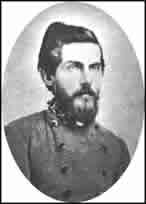
Col. James G. Martin
The organization of the volunteers was entrusted initially to the adjutant-general of the State, Colonel John F. Hoke,
but he was succeeded in July, 1861 by Colonel James G. Martin a one-armed veteran of the Mexican War.
To meet the initial expenses of raising and organizing the troops provided for, the Legislature in May authorized
the issuance of bonds to the amount of $5 million. The die was cast and North Carolina set herself grimly to
the problem of turning a peace-loving agricultural community into an armed military camp.
The Patriots of Person County:
“Roxboro’s and Person county’s contribution to the war was most worthy. John Graves Dillehay
was the first captain of volunteers that went to the war from this county in April or May, 1861.
John L. Harris was captain of the second, John C. VanHook of the third, John G. Jones
of the fourth; James Holman succeeded Dillehay as captain of the first company.
Captains Harris, VanHook and Jones were all promoted to the rank of Colonel. In fact, as I remember,
Colonel Jones was made brigadier-general by the War Department for gallant service on the battle field.
He was killed in action near Petersburg before he took command of his brigade.
(Reminiscences, A Sketch and Letters Descriptive of Life in Person County, Alexander R. Foushee, pp. 64-65)
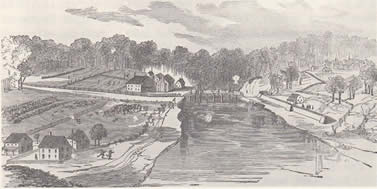
Kinston Early in the War
Lenoir County Prepares for Defense:
“Lenoir County’s company of the North Carolina Guards entered service on May 20, 1861, the very day the
State seceded, and soon became Company I of the 27th Regiment. The “Tuckahoe Braves” were organized
on May 10 and became Company K of the same regiment, while the “Dixie Rifles,” organized on May 18,
became Company H. The “Lenoir Braves,” a unit of heavy artillery, organized on June 12 and eventually
joined the 40th Regiment as its Company A. This group was among the State’s first troops sent to
garrison some of the forts seized along the coast. It served at Fort Hatteras and at other forts near the
mouth of the Cape Fear for most of the war.
As a part of the feverish preparation, supplies were gathered at Kinston…Training camps sprang up
in Lenoir County along the Atlantic and North Carolina Railroad just as they did in a great many
other places where transportation for troops was convenient. Blackjack Camp near LaGrange and
Camp Campbell and Camp Johnston near Kinston were among those important enough to have
names. Seasoned veterans of the Mexican War, militiamen, and former students at some of the
State’s military schools were pressed into service to drill troops and train them in the bare essentials
of military routine which they soon put into practice.
A bakery on Queen Street in Kinston was operated to produce “hard tack” on a large scale. This was
crackers made for use of the marching army and consisted of flour, salt and water. Shoes for Confederate
forces were also made in Kinston. The Washington family operated the shoe factory, also on Queen Street,
and in connection with it had a large tannery on the river side of Heritage Street at the intersection of Gordon.”
(The Story of Lenoir County and Kinston, North Carolina, William S. Powell, NCDAH, 1963, pp. 43-44)

Flag of the First North Carolina Regiment
Among the first commissioned colonels were Daniel H. Hill, George B. Anderson, William D. Pender,
and Junius Daniel, all former soldiers of the United States army and all destined to high rank and fame in the
Confederate army. The First North Carolina Regiment was organized by Colonel D.H. Hill at Camp Mangum at
Raleigh on May 11; by May 21 it had reported for duty at Richmond and was on its way to Yorktown to join
General Magruder’s forces, which were guarding Richmond from attack by way of Fortress Monroe.
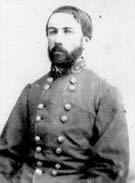
Daniel Harvey Hill
By May 22 the Second Regiment, trained at Garysburg by Colonel Sol Williams, another West Pointer, was
also on its way to Richmond. Early in June the Third Regiment under Colonel Pender, and the Fourth under
Colonel Daniel, joined the army defending the capital of the Confederacy. Back in North Carolina, in training
camps at Raleigh, Warrenton, Ridgeway, Halifax, Garysburg, Company Shops (now Burlington), and Asheville,
hundreds of raw recruits were being rapidly organized into companies and regiments, and as fast as possible
shipped away to points of danger, some to Virginia, others to the North Carolina coast.
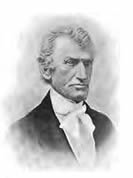
Thomas Ruffin
At a secret session held in early June, the Convention appointed Thomas Ruffin and William A. Graham
a committee to confer with President [Jefferson] Davis relative to the transfer of North Carolina’s military
and naval forces to the Confederacy under the provisions of an act of the Confederate Congress. Davis declared
that the Confederate government would accept the ten regiments of State troops and six regiments of the
twelve-months volunteers, four of which were already in the field, but that in the future, all general and staff
officers must be appointed by the President. A similar disposition of the State’s naval forces was proposed.
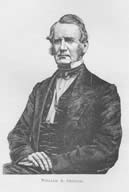
William A. Graham
Ruffin and Graham thought the proposition unconstitutional and so reported to the Convention, but that body,
faced by the enormous expense of the war if North Carolina continued to support her own troops, took no
notice of their opinion. On June 27 the Convention adopted an ordinance to carry the arrangement into effect.
Within seven months after her secession North Carolina had turned over to the Confederate government 40,000 men,
armed and equipped for service. This, however, was only the beginning, for throughout the war the most insistent
call of the Confederacy was for men, first as volunteers, later as conscripts. The great majority of North Carolina
troopswere volunteers. Of the total of 125,000 enrolled in the various branches of the service during the war,
only 18,585 were conscripted.
On November 19, 1864, the adjutant-general made the following report of the various classes of troops
furnished by North Carolina up to that date:
Troops transferred to the Confederate service: 64,636
Conscripts to September 30, 1864: 18,585
Volunteers since date of original rolls: 21,608
Number in regiments of other States: 3,103
Regulars in State service: 3,203
Total offensive troops: 111,135
Junior Reserves: 4,217
Senior Reserves: 5,686
Total troops in active service: 121,038
Home Guard & Militia: 3,962
Total in State and Confederate service: 125,000
In 1860, the total military population of North Carolina was only 115,369!
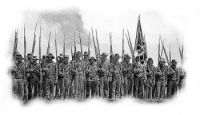
There were but few trained officers in the State in 1861, and the majority of those who commanded
her troops had to be trained in the regiments. In the First North Carolina Regiment, for instance, were trained five
generals, and seven officers of the general staff, fourteen colonels, ten lieutenant-colonels, eight majors, twelve
adjutants and ten other staff officers, fifty-seven captains, and eighty lieutenants. Altogether North Carolina furnished
the Confederacy with two lieutenant-generals – Theophilus H. Holmes and Daniel Harvey Hill; eight major-generals –
Robert Ransom, Matt W. Ransom, William Dorsey Pender, Robert F. Hoke, W.H.C. Whiting, Bryan Grimes,
Stephen D. Ramseur, and Jeremy F. Gilmer; and twenty-six brigadier-generals.
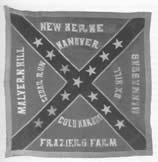
The Thirty-seventh North Carolina:
“All across the State, men began to enlist in companies, often led by important men in local communities.
These companies gave themselves grandiose names, such as the “Enfield Blues,” the “Halifax Light Infantry,”
the “Washington Grays,” the “Hornet’s Nest Rifles,” or the “Southern Stars.” The companies often congregated
near Raleigh at one of the training camps, where they formed groups of ten companies and received a
numerical or regimental designation. Afterwards they elected their field officers and were sworn into State,
and later Confederate, service.
Some 2,021 men would eventually serve under the banner of the Thirty-seventh [North Carolina] Regiment.
They would come from a diversity of backgrounds, occupations, talents, and ages. One thing is certain:
as the war progressed, they would become one of the best fighting forces in Robert E. Lee’s Army
of Northern Virginia. They would have their moments of victory, trial under fire, and their seasons of defeat.
And they were men. The overall age of a member of the regiment was 30.4 years. The oldest member,
at the age of 65, was Alexander County resident, Private Edward Turner. Fellow Company G member
Private James Campbell was 56 when he enlisted. On the other end of the age bracket, the youngest
enlistees appear to have been Demarcus Hodges and Levi Potter. They were both from Watauga County
and both of the tender age of 15. There were many 16-year-olds who enlisted. Several…actually served,
most notably Dallas M. Rigler, a Mecklenburg County native who would rise to the rank of Third Lieutenant
of Company I. He was wounded at least three times before being captured at Petersburg, Virginia.
Their occupations were as varied as their ages. The vast majority were farmers, as was the case
in most of the Confederate regiments….[but also] two lawyers, seven teachers, three clergymen, two
coach makers, two millwrights, twenty-three carpenters, two doctors, eight students, six merchants,
four mechanics, two wheel-wrights, three miners, two masons, and at least one each of harness
makers, blacksmiths, printers, cabinetmakers, saddlers, shoemakers, tinners, paper makers, moulders,
clerks, artists, and cotton spinners. Added to this were at least 852 farmers, who owned farms of
varying sizes, to produce a colorful mixture.”
(The Thirty-seventh North Carolina Troops, Michael C. Hardy, McFarland & Company, 2003, pp. 9-10)
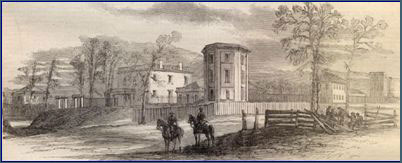
The Arsenal at Fayetteville:
In the early days of the war men were to be had in abundance; indeed, they volunteered in such large numbers
that hundreds were turned away by recruiting officers, who had their pick of the flower of the youth of the State.
What was needed in 1861 was equipment. The immediate need in May, 1861 was partially met by the
seizure of the United States arsenal at Fayetteville by State troops on April 22, despite the fact that at the time
North Carolina had not seceded from the Union. From the arsenal the State procured 37,000 stand of arms,
a battery of field pieces, a small supply of powder and other military stores, and machinery for the
manufacture of the munitions of war.
Of the muskets thus acquired, 10,000 were promptly turned over to Virginia for her troops, and a smaller
number to other States. The remainder were used to arm the North Carolina troops. Many of the muskets found
in the Fayetteville arsenal were flintlocks which dated as far back as the Revolution. As soon, however, as workmen
could be found to operate the machinery taken with the arsenal they were put to work changing the locks on those
old guns. Infantry companies were sent to Virginia without rifles and artillery companies without cannon, literally to
wait until arms could be purchased for them, or captured from the enemy.
(North Carolina, Rebuilding an Ancient Commonwealth, Volume II, R.D.W. Conner, AHS, Inc., 1929, pp. 174-193)
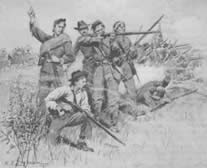
God Bless the Ladies!
The following speaks for itself and for the brave, patriotic ladies who have set this bright example:
“Greene County, North Carolina, April 28, 1861.
To His Excellency, John W. Ellis, Governor of North Carolina:
Sir: -- We, the undersigned, hereby tender our service to the State as nurses, or in any other capacity
in which we can aid our brave volunteers. We are willing and ready to take the field with them and
there minister to the wants of the wounded. Hoping that your Excellency will accept our tender,
we have the honor to be, Your Excellency’s obedient servants,
Sarah Corinne Hunnicutt, Annie E. Williams, Kate J. Randolph, Emma F. Williams”
(Medical and Pharmaceutical Conditions in the Confederacy, pp. 98-99)
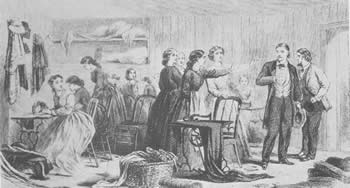
Contributing to the Comfort of Their Gallant Defenders:
“The ladies of Raleigh, having formed themselves into a society for the purpose, are busily engaged
in contributing by their labor to the defense of the State. During last week they made and turned
over to the Adjutant-General, for the use of the troops:
1500 mattresses and 600 towels for the Camp of Instruction; 300 uniform jackets;
200 uniform pantaloons; 400 fatigue shirts; and 200 haversacks.
The materials were purchase mainly by contributions amongst themselves. The basement of the new
Baptist Church having been kindly tendered by Rev. Dr. Skinner for the purpose, it is occupied
by the cutting and distributing department; whilst the offices of the Governor and Private Secretary
in the Capitol, at first, and afterwards the Commons Hall, accommodate the sewing machine department.
In these several rooms can be seen daily the ladies whose fingers have not been used to work, and
the lady whose fingers yield her daily support, and in the background several free colored women
whose services were voluntarily tendered – all laboring earnestly in the patriotic work and
contributing to the comfort of their gallant defenders.”

Death of Our Governor
“I am trying to do my duty -- & be sure that I understand too well ever to make an unnecessary….risk of the life
which belongs to my family as well as myself.” Charles F. Fisher to his sister, July 17, 1861.
On July 3, 1861, the [Sixth North Carolina] regiment was officially transferred to the service of the
Confederate States. This probably meant an early transfer to the seat of war in Virginia. The men entrained
without incident on July 8 for Raleigh, passing through Hillsboro to the cheers of “a large portion of the ladies
and citizens of the town, and many from the country around,” who had assembled at the depot to see them pass.
Upon arrival at Raleigh, the men received the sad news. Governor [John W.] Ellis had died “on the 7th inst,
at the Red Sulphur Springs Va.” Fisher was directed to….”detail two companies of your Regt under
Major [Charles E.] Lightfoot, for the purpose of proceeding to Petersburg to escort the body to this place.”
The remainder of the regiment was ordered to remain in Raleigh to be held “in readiness “ to form
the funeral escort. These were sad beginnings for an illustrious career. Lieutenant Colonel [William T.] Dortch
was ordered to go to Tarboro to “accompany Mr. Clark here.” The last honors to North Carolina’s deceased
governor had to be carried out even though Confederate President Jefferson Davis had been informed that
the regiment would be at Richmond “ten days ago.”
Henry T. Clark, North Carolina’s new governor, assured Confederate Secretary of War Leroy P. Walker
that the regiment “will leave tomorrow and will be subject to your orders and is now formally tendered.”
At 9:30 A.M. on July 10 the remains of Governor Ellis, escorted by Company B and C of the Sixth Regiment,
arrived at the depot of the North Carolina Railroad in Raleigh. The governor’s body was “removed from
the cars and escorted to the Capitol by the military guard,” where the State flag was placed over the coffin.
The Raleigh Register described the funeral procession:
“At 10 o’clock the procession moved from the south gate of the Capitol down Fayetteville Street
to the Executive Mansion, in the following order: Brigadier General Gwynn, State Troops commanding,
aided by Captain A.D. Moore. 1st Music, 2nd, Sixth Regiment of Infantry, Col. Fisher,
3rd. Ellis Light Artillery, Maj. Ramseur, 4th, Hearse with the body, 5th. Pall Bearers,
6th Reverend Clergy, 7th Surgeon General and Medical Staff, 8th, Family and relations of deceased,
9th, Governor of State, 10th Speaker of House of Commons, 11th, Officers of the Executive Departments…."
On the morning of the 11th “about 8 o’clock”….the coffin was escorted from the mansion to the
North Carolina Railroad….deposited on the train, and sent to the Ellis family burying ground near
Holtsburg, Davidson County. While these obsequies were in progress, the business places in Raleigh
were closed and private homes were draped in mourning. The public buildings in Raleigh “and the statue
of Washington on the Capitol Square” were also draped. All flags were lowered to half-mast, bells tolled,
and “half-hour guns fired during the day by a detachment of the Wilmington Light Artillery.”
(The Bloody Sixth, The Sixth North Carolina Regiment, Confederate States of America,
Richard Iobst, Butternut Press, 1987, pp. 15- 16)
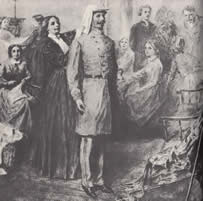
Soldiers Aid Society of the Ladies of Wilmington:
Wilmington, August 7, 1861.
“Editors of the Journal: -- In accordance with the notice given in the [State] Journal some days ago,
a meeting was held yesterday morning at the City Hall for the purpose of organizing a
“Soldiers’ Aid Society of the Ladies of Wilmington.”
The meeting was opened with a prayer by Rev. Mr. Guthrie; a constitution was then
submitted by Rev. Mr. Drane, and adopted by unanimous vote. The objects of the Society
are thereby declared to be “to give system and increased efficiency to the efforts now being
made, or hereafter to be made, to aid our absent volunteers, and to provide, as far as practicable,
for the wants of those who may be visited by disease, or wounded in battle.”
The following ladies were then elected officers of the Society:
Mrs. A.J. DeRosset, President; Mrs. Dr. Dixon, Vice President; Mrs. Gaston Meares, Secretary;
Mrs. J.H. Russell, Treasurer. Mrs. Lyons, Mrs. Hart, Mrs. Stevenson, Mrs. C.H. Robinson, Mrs. Drane,
Mrs. McGuire, Mrs. Thomas, Miss Elby Ellis, Mrs. Bowden. Executive Committee.
Public Meeting in Randolph:
“A number of the citizens of Randolph County, N.C., feeling it their duty to contribute clothing for
the comfort of our gallant volunteers, assembled at Fox’s Store, Sandy Creek, in said county,
on the 5th of September 1861, for the purpose of devising some expedient way for making
a contribution of clothing and delivering said clothing to our volunteers.
On motion of John Fruit, Esq., Dr. M.L. Fox was called to the chair, and S.C. Fox, Esq., was
appointed Secretary. After a short retirement of the committee they reported the following resolutions:
Resolved, That we heartily sympathize with our brave volunteers, who have forsaken their homes and
all dear to them, to fight not only for their rights, but also for ours; and that we feel it our duty to contribute
freely for their comfort during their service in the defense of our common country.
Resolved, That we will liberally contribute woolen blankets, woolen shirts, woolen drawers, woolen
socks, and woolen gloves for Captain Odell’s, Captain Gray’s, and Captain Worth’s companies –
volunteers from Randolph Count, in the 12th Regiment N.C. Volunteers.
Resolved, That a copy of the proceedings of this meeting with the request to publish them, be sent
to the editors of the North Carolina Standard and Greensboro Patriot.
S.C. Fox, Secretary, M.L. Fox, Chairman”
(The North Carolina Standard, September 18, 1861)
Sources and Bibliography:
Journal of a Secesh Lady, Catherine Edmundston, Crabtree & Patton, editors, NCDAH, 1979
Medical and Pharmaceutical Conditions in the Confederacy, E. Vernon Howell, Edwards & Broughton, 1918
“John Motley Morehead and the Development of NC, 1796-1866, Burton Alva Konkle, W.J. Campbell Publisher, 1922
Reminiscences, A Sketch and Letters Descriptive of Life in Person County in Former Day, A. R. Foushee, Roxboro, NC, 1921
Copyright 2011, North Carolina War Between the States Sesquicentennial Commission
